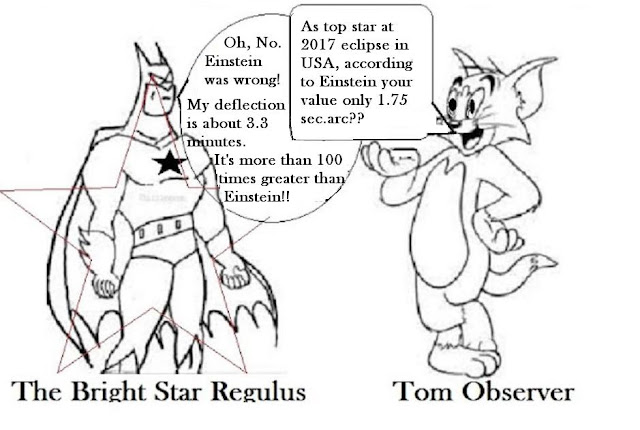Prediction at 2017 solar eclipse, August 21, in USA
The first calculation of the deflection of light by mass was published by the German astronomer Johann Georg von Soldner in 1801. Soldner showed that rays from a distant star skimming the Sun’s surface would be deflected through an angle of about 0.9 seconds of arc, or one quarter of a thousandth of a degree. This angle corresponds to the apparent diameter of a compact disc (CD) viewed from a distance of about 30 kilometers (nearly 20 miles). Soldner’s calculations were based on Newton’s laws of motion and gravitation, and the assumption that light behaves like very fast moving particles. As far as we know, neither Soldner nor later astronomers attempted to verify this prediction, and for good reason: Such an attempt would have been far beyond the capability of early 19th century astronomical instruments.
Light deflection in general relativity. Over a century later, in the early 20th century, Einstein developed his theory of general relativity. Einstein calculated that the deflection predicted by his theory would be twice the Newtonian value.The following image shows the deflection of light rays that pass close to a spherical mass. To make the effect visible, this mass was chosen to have the same value as the Sun’s but to have a diameter five thousand times smaller (i.e., a density 125 billion times larger) than the Sun’s.(www.einstein-online.info).
How, exactly, did Newton fail? We know that Einstein’s general relativity is superior to Newton’s gravity, but where did Newton go wrong?
These were small numbers, but a joint expedition by Arthur Eddington and Andrew Crommelin during the 1919 solar eclipse, were able to measure to the necessary accuracy. The deflection they came up with was 1.61″ ± 0.30″, which agreed (within the errors) with Einstein’s predictions, and not with Newton’s. Newtonian gravity was busted.
And that’s the story of not only Newton’s gravity being superseded, but in what way(s) Newton’s theory came up short. There have been many other victories for general relativity since (and, honestly, no failures as of yet), but in all the cases where Newton’s and Einstein’s theories differ, it’s Einstein — with stronger gravitational effects close to massive bodies — who emerges victorious. Science marches forward, but sometimes each new step takes a very long time!-Ask Ethan #106 How Exactly Did Newton Fail?
Figure 1: Bending light-sciencenews.org
It is interesting to note, first, on the einstein-online that says ‘Einstein calculated that the deflection predicted by his theory would be twice the Newtonian value.’. Second, on the sciencenews.org that explains the bending of light as seen from Earth; shift angle 1.75 seconds of arc.
First, Newton himself never predicts deflection of light by the Sun; to be more precisely, absence of evidence about it. Newton never mentioned the bending of light is about 0.9 seconds of arc.
A paper of Domingos S.L.Soares, ‘Newtonian gravitational deflection of light revisited’, submitted on 3 Aug 2005; describes the angle of deflection of a light ray by the gravitational field of the Sun, at grazing incidence, is calculated by strict and straightforward classical Newtonian means using the corpuscular model of light. The calculation is presented in the historical and scientific contexts of Newton’s {\it Opticks} and of modern views of the problem.
Domingos S.L.Soares drew a conlusion, there is still the question of why Newton did not discuss the possibility of light ray deflection by a massive heavenly body. Of course, he was well acquainted with the relevant astronomical observations.Solar eclipses were certainly of his knowledge and could certainly motivate digressions on the gravitational bending of light.
Second, general relativity also predicts that gravity should bend light, but for very different reasons. In general relativity, a massive object distortsspacetime itself, and light simply takes the straightest path. You have to work through the numbers, but if you do, you discover that this means light bends twice as much in general relativity as in Newtonian gravity.
According to Einstein, the star light visible around the sun would be bent inwards, toward the sun at the time when passing through the gravity field of the sun. Einstein calculated the level of their deviation and predicted that for the stars observed being the closest to the Sun, their deviation was about 1.75 seconds of arc-See Figure 1.
For more than 100 years all physicists and astrophysicists are very familiar with the illustration in Figure 1 above; but, did they realize that the above illustration has no meaning whatsoever? Has no meaning is the same with nonsense. The above illustration shows exactly how Einstein has been a failure to understand of astronomy.
What is the reason?
This prediction is not meaningful in scientifically of astronomy when it is not explained the altitude of the Sun.
The important things to be noted, the amount of 1.75 seconds of arc without mentioning the altitude of the Sun as the object of observation. This is a fatal mistake; or something like a joke; because the deviation of starlight will always vary depending on the altitude of the object of observation.


















